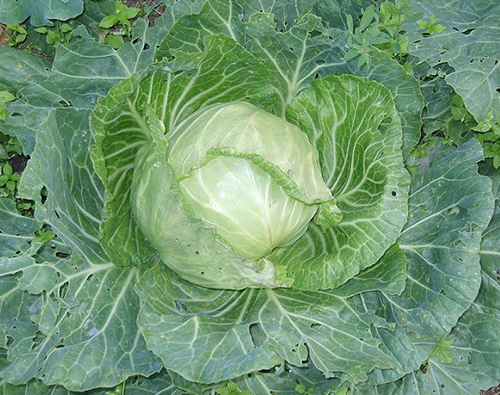Cabbage variety Transfer (F1)
Transfer - an early ripe hybrid of White Cabbage (Brassica oleracea var. Capitata). In 1993, it was included in the state register of the Russian Federation for 11 regions (Far Eastern, East Siberian, West Siberian, Ural, Lower Volga, Middle Volga, North Caucasian, Central Black Earth, Volgo-Vyatka, Central and North-West). Suitable for commercial production. Originators: Selection station named after N.N. Timofeeva (Moscow) and All-Russian Research Institute of Rice (Krasnodar).

The period from germination to technical ripeness is 96 - 100 days. From planting seedlings in the ground to harvesting, 50 - 55 days pass. Cabbage Transfer ripens 5 - 7 days earlier than the variety June and 8 - 10 days earlier than the variety Number one Gribovsky 147.
The leaf rosette is compact, semi-raised. The leaves are round, slightly bubbly, light green in color with a waxy bloom of medium intensity; the edge of the leaf is slightly wavy. Heads of cabbage are small, rounded, weighing 0.8 - 1.5 kg, white on the cut, of medium density, with slot-like voids along the periphery; the outer color of the head is greenish-white. Internal stump of short length. The average yield of marketable heads of cabbage is 215 - 380 c / ha, which is 19 - 45 c / ha higher than that of the standard June variety; maximum yield - 630 c / ha (data for the Oryol region); yield per square meter - 5 - 7 kg. The output of marketable products is high - 94%. Maturation of heads of cabbage is amicable (8 - 10 days).
Cabbage Transfer is recommended for fresh consumption and culinary processing. The tasting assessment of the taste of this hybrid is 4 - 4.8 points. The chemical composition is as follows: dry matter 6.4 - 7.8%, total sugar - 3.2 - 4.1%, ascorbic acid - 32 - 50.1 mg%, protein - 0.8 - 1.3%.
This hybrid is resistant to head cracking, relatively resistant to damage by cabbage flies, and withstands early spring cold snaps and freezes down to minus 5 ° C. Differs in high and stable productivity, as well as amicable yield of the harvest.









Usually from early varieties of cabbage I plant "June", but somehow I decided to try "transfer", as it was promised earlier ripening. Sowed in April, the seeds sprouted together, they went well into growth. But the seedlings did not tolerate the picking well, perhaps it was my mistake, it was necessary to sow less often, and then just thin out the seedlings, and not transplant. When she got stronger, she landed in the garden. I used ash from the cabbage fly. It ripens really amicably, but not as early as I expected. And the forks are small, so I went back to June. She is less capricious, as it seemed to me, and the forks are bigger. Although it is possible that the "transfer" does not really like the cool climate of our area.